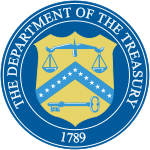The following are some of the larger institutions that were regulated by the OTS:
Indymac
In March 2008, OTS Director John M. Reich stated that the Savings and Loan industry remained vibrant due to the effectiveness of regulators. [17] Reich blamed Indymac's 11 July 2008 failure on $1.3bn of withdrawals in the fortnight following concerns raised from Senator Chuck Schumer over the bank's solvency. [18] [19] Schumer faulted the OTS. [20] The failure of IndyMac Bank was the fourth largest bank failure in United States history. [21] Prior to IndyMac's failure on 11 July 2008, the bank had come to rely heavily on higher cost, less stable, brokered deposits, as well as secured borrowings, to fund its operations. The bank had focused on stated income and other aggressively underwritten loans in areas with rapidly escalating home prices, particularly in California and Florida. [22]
On 21 July 2008, Mr. Reich described "interference with the regulatory process by reporting and disseminating speculation about the condition of financial institutions, thereby undermining public confidence in those institutions and causing serious harm" as a contributor to the failure of IndyMac as well as Fannie Mae, Freddie Mac and Lehman Brothers. [23]
On 22 December 2008, Mr. Reich removed his agency's western director, Darrel W. Dochow for allowing IndyMac to backdate a capital infusion of $18 million from its parent company so that the bank would appear "well capitalized" in its 10-Q for the period ending 31 March 2008. According to a source with knowledge of the incident, at another point Mr. Dochow limited the scope of a review by OTS regulators of IndyMac's portfolio of loans and other assets, overruling the advice of others in the agency. [24] Mr. Dochow played a central role in the savings-and-loan scandal of the 1980s, overriding a recommendation by federal bank examiners in San Francisco to seize Lincoln Savings, the giant savings and loan owned by Charles Keating. Mr. Reich called the backdating irregularity "a relatively small factor" in the collapse of IndyMac. [25]
On 12 February 2009, Mr. Reich resigned, announcing he would step down 27 February. [26]
On 26 February 2009, the Treasury Department's inspector general released a report citing laxity at the OTS under Reich for adding significantly to the $10.7 billion in FDIC losses from the IndyMac failure, as well as the estimated $270 million in losses suffered by uninsured depositors. The report concluded that, under the law, OTS should have taken Prompt Corrective Action against IndyMac in May 2008. [27] Commenting on the report, Inspector General Eric Thorson dismissed Reich's claim that Senator Schumer's letters caused the failure. Marla Freedman, the assistant inspector general for audit, detailed a pattern of excess risk-taking and abuse of the lending process at IndyMac and the OTS's consistent and concurrent failure to act. Mr. Reich said in a letter to the inspector general that he agreed with the agency's filings. [28]
On 27 February 2009, Mr. Reich stepped down amidst the continuing audit of backdating at IndyMac and four other institutions. [29] Scott Polakoff, OTS senior deputy director and chief operating officer, hired under Mr. Reich, became acting director on his departure.
On 26 March 2009, Polakoff was removed and placed on leave by United States Secretary of the Treasury Timothy Geithner, amidst an announced further review and investigation of the backdating scandal by the U.S. Treasury's Inspector General. [30]
AIG
The OTS was pressed by the Senate Banking Committee to admit partial blame for the failure of American International Group (AIG). [31] In a congressional hearing, after Donald Kohn described how there was no regulator for AIG Financial Products or the company overall, Scott Polakoff interrupted. [32] [33] Polakoff stated that it was time for the OTS to take some responsibility because they had been "deemed an acceptable regulator for both US domestic and international operations". [34]
Due to OTS regulation of AIG, the Mayfair-based (London, UK) AIG Financial Products division was not subject to Financial Services Authority regulation. [35] OTS regulation allowed France's Commission Bancaire [ fr ] to grant approval for a Paris-based banking subsidiary, Banque AIG. The Mayfair-based AIG Financial Products division then opened under a system which allowed branch openings in member countries after one EU regulator's approval.
That OTS was the primary regulator of AIG has been described as "nonsense" [36] and compared to "the super-heavyweight of the world going up against the 65 lb, 13-year-old, class weakling". [37] AIG operates in 130 countries. [38] The OTS had a small division that monitored derivatives including the credit default swaps at AIG. [39] After a dispute with Goldman Sachs in 2007 over the value of the credit default swaps, [40] the OTS did not initiate formal enforcement action, but "periodically raised concerns with AIG managers". [39] Other sources of concern were the three credit rating agencies and AIG's auditor PricewaterhouseCoopers. [40] In March 2008, after AIG disclosed valuation problems, the OTS sent a letter to AIG requesting a "corrective action plan" in 30 days. [39] The division overseeing AIG Financial Products was "quietly disbanded" and AIG missed their deadline. [39]

